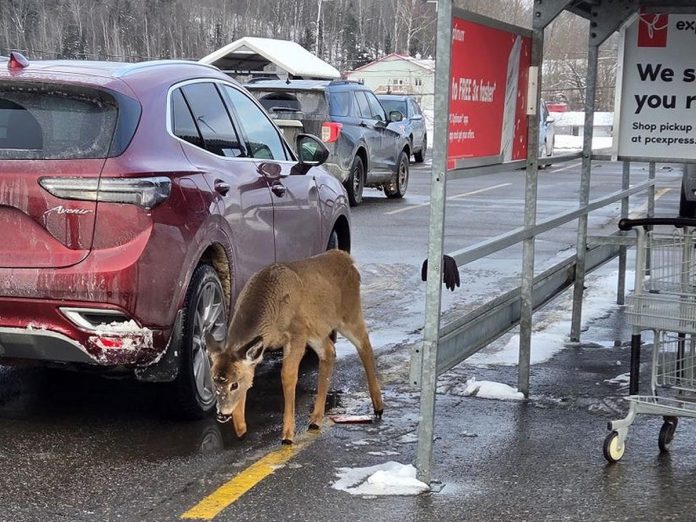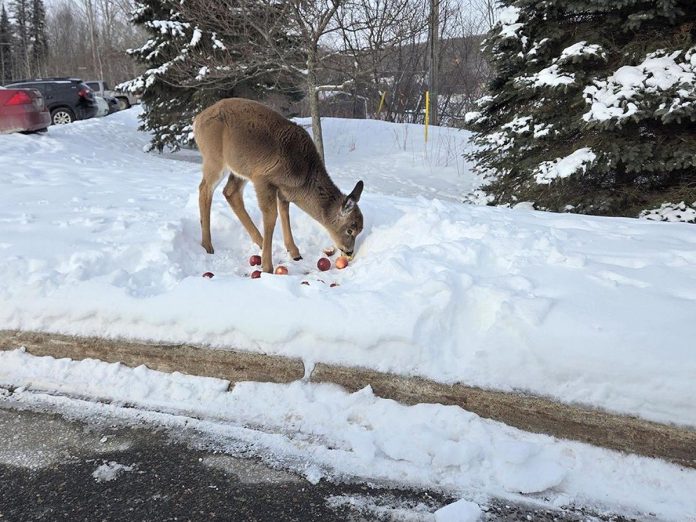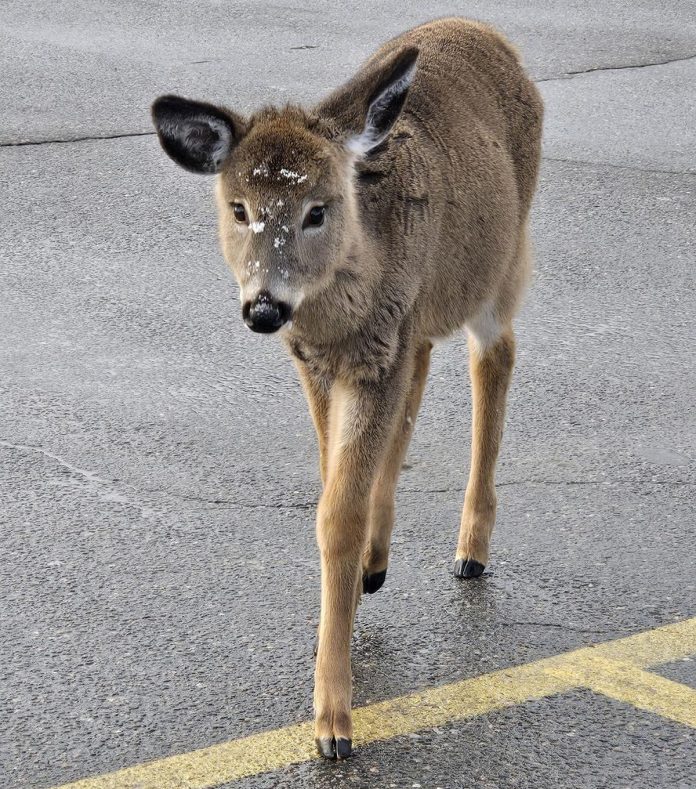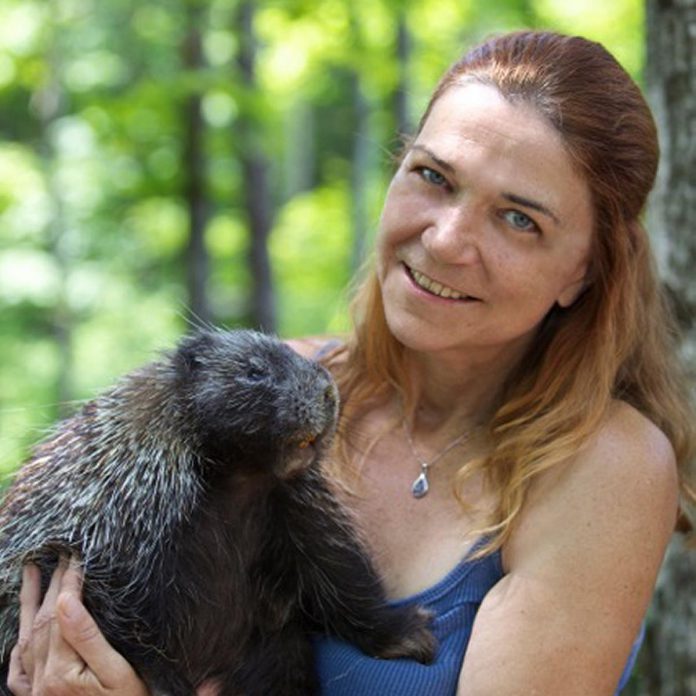
The Woodlands Wildlife Sanctuary in Minden is warning residents they are “killing with kindness” when they feed a young deer that has been hanging around Todd’s Your Independent Grocer in the village of Haliburton.
Aptly named ‘Mooch’ by the sanctuary’s founder Monika Melichar, the fawn has been frequently spotted outside the store begging for food in the parking lot for likely up to the last six weeks.
Though the Municipality of Dysart et al passed a by-law banning deer feeding in 2023, shoppers have fallen prey to the animal’s cuteness and have been providing Mooch with apples, carrots, corn, and other food items.
“He’s being taught to be domesticated, and that is our biggest concern,” Melichar says. “As a community, we’re teaching him that it’s okay to come into the parking lot and mooch for food, because we give him that positive reinforcement by providing him with food. He’s young and he’s naive, so that quickly teaches him that it’s a good place to go because he’s getting that juicy apple.”
Born last summer, Mooch — who Melichar calls “he” although the fawn has yet to be identified as a doe or buck — is with a herd that often stays along the edges of the forest behind the grocery store, though is the only one who dares venture into the parking lot.
Based on photos from last summer and given that fawns are typically still with their mother at this age, it’s believed that Mooch lost his mother in late fall last year after she was struck by a vehicle.

Melichar suggests that while it’s hard to walk past Mooch without offering food because the fawn is “so darn cute,” continuing to do so could cause problems in the future. If Mooch is a buck, when he enters rutting season he could become “aggressive” and “demanding” to the people who once supplied him with food.
“He will be stronger, and he can jump on people. If they’re holding an apple, let’s say, and eating it themselves, not intending to feed him, he will jump up and try to take that apple,” she explains.
“That’s what happens when a deer becomes unafraid of humans. Deer are strong and have razor-sharp hooves, so if they paw at somebody they can actually slice skin open.”
Melichar is also concerned that Mooch’s comfort around humans provides more opportunity for the fawn to be hit by a vehicle. Just this month, Haliburton Highlands OPP reported that a recent traffic analysis saw a “concerning” rise in motor vehicle collisions, with deer-related collisions accounting for 82.5 per cent of these incidents. Hotspots from 2019 to 2023 include Country Road 21 and Highway 118.
“It’s because we are more in the bush, but it’s also because the deer are becoming unafraid of human activity and commotion and will mingle among cars and cross the roads even when cars are coming,” Melichar says about the frequency of deer-related accidents.
She adds that the very day after Woodlands Wildlife Sanctuary assessed Mooch, a deer that had been hit by a car was found in a ditch near the grocery store and had to be shot by the OPP because he suffered such terrible injuries.
“This is what we really need to stop. It’s too sad to have the constant injuries and car collisions happening,” says Melichar.

Melichar also says that feeding deer can be harmful to the animals, as oftentimes they are being given food they would not find naturally when foraging during the winter, when their diet consists of twigs, branches, bark, and winter-green plants.
For example, people who feed deer will commonly give them corn. While deer love corn, it takes a lot of energy to digest and having such a high-carbohydrate diet can cause nutritional and developmental problems for deer. They can even develop “Aladdin’s Slippers,” a disease that causes the hooves to curl upward.
“Sadly, that is not uncommon in this area and there are a few deer suffering from that right now, and it’s directly linked to feeding them corn.” says Melichar. “They love corn — it’s like candy to them — but they’re not getting the nutrients they need to develop properly.”
While deer feeders might be quick to suggest that deer need help sourcing food during the cold spells, Melichar says the Woodlands Wildlife Sanctuary found Mooch to be completely physically healthy and “has no issue of being starved.”
It is true that deer face challenges in accessing food in the winter with the build up of deep snow, and Melichar recognizes that feeding wildlife can be a source of joy for many people in Haliburton. She just encourages people to think about how they’re doing it.
“People like to feed the deer because there’s nothing more beautiful than seeing a little group of deer eating in your front yard, but let’s be reasonable and smart about it,” she says. “Do it with the deer’s welfare in mind.”

She suggests deer should be fed on individual properties and far away from the roadside and the danger of vehicles. Instead of feeding them corn, give them other grains such as oats. It can also be helpful to collect boughs and sticks and leave them on top of the snow.
“Deer like cedar this time of year, so cedar boughs are beautiful, and it feeds them a more nutritious, natural diet as opposed to corn and molasses, which is terrible junk food and can cause those deficiencies in the deer,” Melichar says.
If residents do feed deer, Melichar cautions against getting too close to them.
“Keep them wild by not taking selfies with them or petting them or coaxing them to come and eat right out of your hand. That is just strictly stroking your own ego and that is not helping that deer and is causing a lot of harm. I call that killing with kindness.”
If deer come too close, Melichar encourages people to “shoo” them away by making lots of noise and waving their arms around to encourage them to return to more forested areas away from people.
“The response is tough love, meaning teach the deer to fear you,” she says. “Put your food out, walk away, and let the dear come. That’s fine, but if you do it with your ego in mind, for your own gratification, those deer are now being taught that you’re a kind person. But not everybody is, and cars are certainly not kind.”
As for Mooch, Melichar suggests the only way to ensure he stays safe is to instill a fear of humans again, rather than reinforcing the idea that humans offer a food source.

Given that Mooch is physically healthy, she does not want to bring the fawn to the Woodlands Wildlife Sanctuary, as it would only be a “band-aid on one deer.” Relocation would only provide a temporary solution, as Mooch would find his way back.
“We need to re-educate the community and just give them the idea and the strength and the power to say ‘I love seeing deer here in Haliburton County and I want the deer to stay’ because, if we keep them afraid, there will be less collisions, less interactions, less raided gardens,” says Melichar.
“We do want to keep our wildlife wild, and the only way to do that is to stop interfering and stop promoting the taming by encouraging the wildlife to be eating out of our hands.”


























